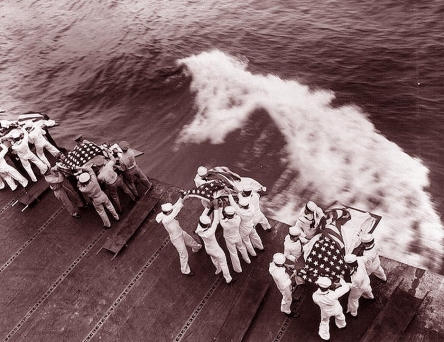World War Two - War at Sea
 Assorted well-campaigned swab-jockeys lounge-about and discuss their various experiences on both oceans.
Click here to read the observations of a general who fought both the Germans and Japanese. A short notice from a May, 1944, issue of The Pathfinder reported that there was a fashion among the American sea-going men of the enlisted variety to wear a particular style of earring in their left ear if they'd experienced combat. Don't take our word for it, read on... A World War Two article from YANK MAGAZINE recalling the sinking of a U.S. Navy aircraft carrier off the coast of the Gilbert Islands -
Four graphs from a 1947 Naval study illustrate the amount of Japanese aircraft and assorted sea faring vessels that were destroyed during the course of World War Two. "The last flight was coming home. The planes circled through the thick mist toward the stern of the Essex-class carrier. One by one they hit the deck: Hellcats, Corsairs and EBMs, with names like 'Hydraulic Bess', 'Miss Fortune', 'Sweater Girl' and 'Kansas City Kitty'...When the air-crewmen came back from their low low-level raids, the thing they talked about most was the lack of Jap opposition."
Click here to read an interview with a Kamikaze pilot.
An essay on the U.S. Navy's progress during the first six months of World War Two. " Japan's decision to launch a war was based on the assumption that the conflict in Europe would render Russia and Great Britain negligible factors in the Far East. It was based on the further assumption that the United States, already committed to near belligerency in the Atlantic could not, even if finally successful in that theater, mount an offensive in the Pacific in less than 18 months to two years and would not in any case be willing to pay the price of total victory in the Pacific."
|
MORE ARTICLES >>> PAGE: * 1 * 2 * 3 * 4 * 5 * 6 * 7 * > NEXT |
|